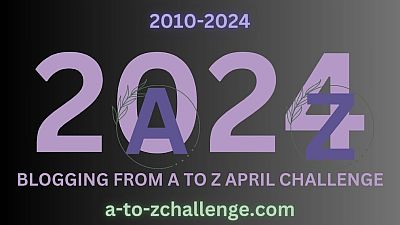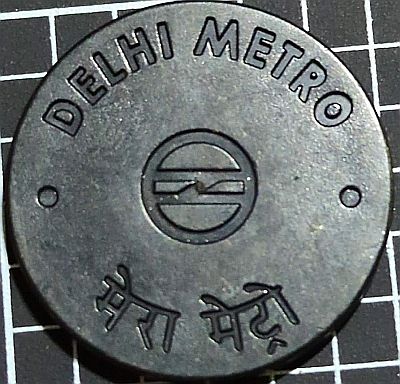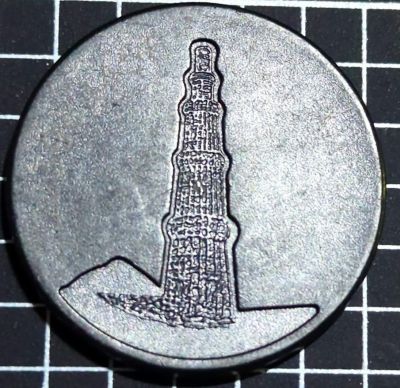A token from one of the largest railway-using countries.
This is my entry for Day 9 “I” of the Blogging from A-Z April Challenge!
I = India.

Indian rail
India is the globe’s overwhelming rail usage leader, with over 8 billion passenger trips per year making up more than a trillion kilometres travelled. Japan is a relatively distant second at roughly 6.6 billion passenger trips covering a far smaller 150 billion kilometres. China ranks third in total passenger trips with just under 3 billion but sees trips making up nearly 950 billion kilometres, making it second most by that metric. All three nations have global reputations for the quality of their systems and their strong integration into domestic travel.

Image of a Hyundai Rotem train on the newest, Grey line which opened in 2019. Note the platform barriers to ensure safety. Image from Wikipedia article on Delhi Metro.
Delhi, officially the National Capital Territory of Delhi (NCT), is a city and a Union Territory of India containing New Delhi, the capital of India. Delhi is the largest city in India and the second largest in the world.
Delhi has an extensive metro with nine lines, denoted by colour, e.g. Orange is the Airport Express line. There are 285 station with a mix of subway, ground level and elevated stations. The final lines planned for the metro are due to be completed by 2025, at which time, the metro will surpass the length of the London Underground. Delhi Metro is the world’s first railway system to get United Nations certification for reducing greenhouse gas emissions.
The frequency of trains ranges from every couple of minutes during peak hours, up to 10 minutes at other times. Services run from 5:30 AM to 11:30 PM.
Obverse

Delhi Metro Rail Corporation (DMRC) commenced operations in 2002 with two types of tokens. Blue for single journeys, and red for return journeys.
The tokens, procured from Japan, were so popular among commuters, that some started keeping them at home in their prayer rooms. A return journey cost Rs 4, equivalent to around 5 US Cents. People would take one journey, but not the return, and keep the token. The tokens were procured from Japan at a cost of Rs 90 each (around $1.10 USD) so was a huge revenue loss for the company. They found a vendor in India and started producing the tokens locally. They stopped the circulation of red tokens, and also introduced souvenir tokens people could buy to take home.
The souvenir tokens introduced by DMRC in 2003 were exact replicas of the regular ones and came in at a nominal cost of Rs 4. The red coloured tokens were discontinued from 2004. Souvenir tokens are sold at the Metro museum at Patel Chowk metro station and select other stations. Since the museum opened in 2009, they used to sell 10 – 15 tokens per month. Since August 2023 when the tokens were phased out, that has jumped to 50 – 60 per month with a total of over 23,000 tokens sold since 2009. DMRC now electronic tickets purchased through WhatsApp, Paytm and UPI. As a backup, paper tickets with QR codes which are scanned at the gate are also available.
The tokens which were used on the system (All single journey except red) include:
- 2002: Red (Return journey)
- 2002: Royal blue
- 2006: Light blue
- 2011: Black
- 2013: Grey
- 2014: Pink
- 2015: Yellow
- 2020: Grey with image of metro on obverse and red logo on reverse.
The obverse of my token has the name DELHI METRO, in English and Hindi – मेरा मेट्रो, with the round logo of the metro between.
Reverse

The reverse of the token depicts Qutb Minar. Built in the early 13th century a few kilometres south of Delhi, the red sandstone tower of Qutb Minar is 72.5 m high, tapering from 2.75 m in diameter at its peak to 14.32 m at its base, and alternating angular and rounded flutings. The surrounding archaeological area contains funerary buildings, notably the magnificent Alai-Darwaza Gate, the masterpiece of Indo-Muslim art (built in 1311), and two mosques, including the Quwwatu’l-Islam, the oldest in northern India, built of materials reused from some 20 Brahman temples.
The design and colours of the tower are impressive. The red and buff sandstone is the highest tower in India. There are photos on the both UNESCO page originally linked, and DelhiTourism.

Detail from the Qutb Minar tower, from Wikipedia
As my token does not have a serial number inscribed on it, I suspect it may be one of the souvenir tokens, although I can’t find a definitive picture or description to be sure. If anyone knows, please comment below! Otherwise, what is your favourite metro system around the world? Do they use tokens, or did they use to? Share you memories below.


Leave a Reply